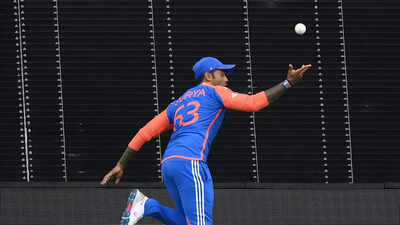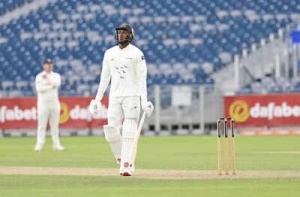The International Cricket Council (ICC) has announced significant alterations to the playing conditions across Test, ODI, and T20I formats. The changes address over rates, ball usage, boundary catches, concussion protocols, and wide deliveries, aiming to enhance the game's flow and fairness.
 *Umpires strategize before a cricket match.*
*Umpires strategize before a cricket match.*
To tackle the persistent issue of slow over rates, the stop clock rule, previously tested in white-ball cricket, will now be permanently implemented in Test matches. The fielding team must commence a new over within 60 seconds of the previous one concluding. Teams will receive two warnings per innings, with subsequent breaches incurring a five-run penalty. These warnings will reset every 80 overs, coinciding with the availability of a new ball.
In One Day Internationals (ODIs), the rule concerning the use of two balls will be modified. The use of two balls will be limited to the first 34 overs. For the remaining 16 overs, the fielding side will have the option to select one of the two balls for continued use. This adjustment intends to more effectively manage the wear and tear of the ball.
The regulations regarding boundary catches have also been updated. Fielders making airborne contact with the ball beyond the boundary must now ensure their final contact point with the ground is entirely within the field of play to complete a legitimate catch. If a fielder steps outside the boundary and jumps again, they are allowed only one additional touch before landing inside the boundary.
Stringent protocols have been introduced for concussion substitutes. Teams will be mandated to pre-nominate potential concussion replacements. Any player diagnosed with a concussion will be required to undergo a mandatory seven-day rest period before being permitted to return to competitive play.
A trial of a revised wide ball rule is set to take place in white-ball formats. The batter’s stance at the moment of delivery, rather than any subsequent movements, will be the determining factor in adjudicating wides. Deliveries passing between the leg stump and the extended protected area marker at the popping crease will no longer be classified as wide. However, deliveries passing behind the batter's legs may still be called wide. To provide clarity for umpires, the protected area marker will be extended to the popping crease to serve as a visual aid.
The Decision Review System (DRS) will now incorporate the actual physical outline of the stumps and bails to define the wicket zone. This enhancement aims to improve the accuracy of LBW (leg before wicket) decisions.
In cases of a deliberate short run, in addition to the existing five-run penalty, the fielding team will now have the prerogative to choose which batter takes strike for the subsequent delivery.
In domestic first-class cricket, a significant change has been introduced regarding injuries. If a player sustains a serious on-field injury at any point after the match has commenced (including during warm-ups), they can be replaced by a like-for-like player for the duration of the game.
The new Test playing conditions came into effect on June 17, starting with the Sri Lanka vs Bangladesh Test match. The revised ODI and T20I rules will be implemented beginning with the same series, starting with the first ODI on July 2 and the T20Is from July 10. All international matches scheduled beyond these dates will be played under the updated regulations.
Newer articles
Older articles
 The 'Good Cop, Bad Cop' Parenting Strategy: Does It Do More Harm Than Good?
The 'Good Cop, Bad Cop' Parenting Strategy: Does It Do More Harm Than Good?
 5 Natural Ways to Strengthen Your Heart and Reduce Disease Risk
5 Natural Ways to Strengthen Your Heart and Reduce Disease Risk
 Broadside: Broad Slams India's Team Choices After Headingley Test, Calls for Edgbaston XI Changes
Broadside: Broad Slams India's Team Choices After Headingley Test, Calls for Edgbaston XI Changes
 Wimbledon Serves Up India: Tennis Giant Courts Cricket-Crazy Nation for Growth
Wimbledon Serves Up India: Tennis Giant Courts Cricket-Crazy Nation for Growth
 England's Ben Duckett: The New Virender Sehwag? Former Coach Draws Bold Comparison
England's Ben Duckett: The New Virender Sehwag? Former Coach Draws Bold Comparison
 Archer Set for England Return? Broad and Buttler Advocate for Pacer's Second Test Inclusion
Archer Set for England Return? Broad and Buttler Advocate for Pacer's Second Test Inclusion
 Ashada Gupt Navratri 2025: Unveiling Dates, Timings, and Esoteric Significance
Ashada Gupt Navratri 2025: Unveiling Dates, Timings, and Esoteric Significance
 Suryakumar Yadav's Sports Hernia Surgery: What It Is, Who's at Risk, and Path to Recovery
Suryakumar Yadav's Sports Hernia Surgery: What It Is, Who's at Risk, and Path to Recovery
 The Evil Eye: Protective Charm or Portal to Darkness? Exploring the Symbol's Dual Interpretations
The Evil Eye: Protective Charm or Portal to Darkness? Exploring the Symbol's Dual Interpretations
 Jaiswal Eyes Gavaskar's 49-Year Record: India's Opener Nears Milestone 2,000 Test Runs in Edgbaston Clash
Jaiswal Eyes Gavaskar's 49-Year Record: India's Opener Nears Milestone 2,000 Test Runs in Edgbaston Clash